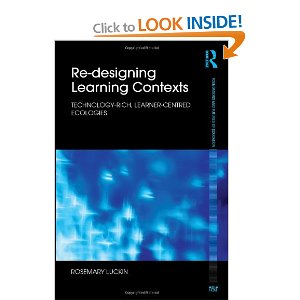Vanessa Pittard DfE, Richard Noss TEL Research Programme Director, BESA, Intellect, ALT, and Demos about research inspired technology enhanced learning to tackle challenges from teenagers’ energy consumption to social communication in a multimodal virtual environment for youngsters with Autism Spectrum Disorders. What the research says event at LKL now has a waiting list for places! Clearly people do want to talk.
Industry, Academia, Educators and Learners: It’s good to talk, but why are we all ‘telephobic’?
March 20, 2012 — Prof. Rose LuckinIn my last post I suggested that to improve learners’ experiences we need research, industry, practitioners and learners to work in harmony, and that this is hard to orchestrate. But why is this hard to orchestrate?
A large part of the reason is that each of these communities ‘speaks a slightly different language’, because whilst they are motivated by some common interests, such as finding ways to help people learn more effectively or enjoyably, they are also motivated by different and in some ways competing factors. To be honest they don’t have a great track record of talking to each other.
Practitioners and learners are the key players in the interactions that support learning, when they work in sync with the right support from technologies developed with and by industry and informed with and by research they can achieve their best. BUT this does not happen as often as it could in the area of Educational Technology and Technology Enhanced Learning.
Why? Perhaps it’s partly because industry works in quarterly cycles with an eye on the ‘bottom line’ and a need to maintain the competitive edge over rivals in order to hold on to or increase market share. It needs to know what will sell when it comes to developing technologies to support learning and what will help to keep employees in work and products on people’s shopping lists. It would often like to develop products informed by research, but with the exception of large industries that have their own research labs, may not know how and when to find the right people to offer that research advice. Researchers are concerned with rigour and clarity, and very rarely think about a year in quarters, more likely in semesters and terms. Their eye is rarely on the bottom line and the results of their endeavour often take a considerable length or time to mature and reach fruition. With a greater imperative to demonstrate the impact of their research as part of the next REF exercise (the system for assessing the quality of research in UK higher education institutions), they may well very much like to find a way to work with industry to take their ideas into a wider community and see how they can be applied. However, who do they talk to and how do they communicate what they know? For most academics they have been well-trained in the art of writing journal articles for approval and acceptance by their peers. But, this type of output is rarely very accessible to people who don’t speak that same academic language.
So why does all this matter? It matters, because the problems we face when it comes to developing the kinds of technologies that can solve the really big educational problems and take advantage of the widespread ownership of powerful communities cannot be solved by any one community on their own, so we really do need to get together and talk about how each community can offer their own contribution to a shared endeavour. In order to do this we need to find a way to understand enough about how each other works to be able to build effective conversations.
As many a famous actor has once said on behalf of BT – “its good to talk”, but you need to know the right number to ring and the right shared language to speak if you are going to have any chance of communicating in any meaningful way. So how can we engineer the circumstances in which such vital communication can take place?

